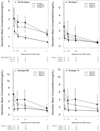Antibody persistence and immunologic memory after sequential pneumococcal conjugate and polysaccharide vaccination in HIV-infected children on highly active antiretroviral therapy
- PMID: 23954381
- PMCID: PMC3825555
- DOI: 10.1016/j.vaccine.2013.08.002
Antibody persistence and immunologic memory after sequential pneumococcal conjugate and polysaccharide vaccination in HIV-infected children on highly active antiretroviral therapy
Abstract
Background: The capacity of pneumococcal vaccination to confer memory in HIV-infected children is critical for durable protection.
Methods: HIV-infected children 2-<19 years administered two doses of pneumococcal conjugate vaccine (PCV7) and one dose of polysaccharide vaccine (PPV) on HAART were randomized 4-5 years later to receive a PCV7 or PPV booster. Total and high avidity antibodies to serotypes 1 (PPV) and 6B and 14 (PCV7 and PPV) were determined by ELISA. Memory was defined as persistence of ≥ 0.5 mcg/mL of serotype-specific antibody on day 0 or change from <0.5 mcg/mL to ≥ 0.5 mcg/mL between day 0 and week 1, or, ≥ 4-fold antibody rise between day 0 and week 1.
Results: Prior to boosting, 4-5 years after the previous PCV7-PCV7-PPV series, geometric mean concentrations (GMCs) were 0.46 mcg/mL (serotype 1), 1.31 mcg/mL (serotype 6B), and 1.47 mcg/mL (serotype 14), with concentrations ≥ 0.5 mcg/mL in 41% (serotype 1) to 82% (serotypes 6B and 14). Memory based on antibody concentration ≥ 0.5 mcg/mL before or 1 week after boosting with PCV7 or PPV was demonstrated in 42-61% for serotype 1 and 87-94% for serotypes 6B and 14, with lower rates based on day 0 to week 1 ≥ 4-fold antibody rise (serotype 1, 3-13%; serotype 6B, 13-31%; serotype 14, 29-53%). Antibody concentrations post-boosting were greater following PCV7 than PPV for serotypes 6B and 14. Ratios of highly avid to total antibody pre- and post-boosting were 0.5-0.8. Predictors of memory included higher CD4% (nadir before HAART and at P1024 and P1061s entry), CD19% (at P1024 and P1061s entry), and antibody response after the PCV7-PCV7-PPV primary series and lower viral load (at P1024 and P1061s entry) and age.
Conclusions: Protective antibody concentrations, high avidity, and booster responses to PCV7 or PPV indicative of memory were present 4-5 years after PCV7-PCV7-PPV in HIV-infected children on HAART.
Trial registration: ClinicalTrials.gov NCT00257127.
Keywords: Children; HIV; Memory; PCV; PPV; Pneumococcal; VL; Vaccine; pneumococcal conjugate vaccine; pneumococcal polysaccharide vaccine; viral load.
Copyright © 2013 Elsevier Ltd. All rights reserved.
Conflict of interest statement
Mark J. Abzug: no commercial or other association that poses a conflict of interest
Lin Ye Song: no commercial or other association that poses a conflict of interest
Myron J. Levin is a consultant to and shares intellectual property with Merck, Sharpe & Dohme.
Sharon A. Nachman: no commercial or other association that poses a conflict of interest
William Borkowsky: no commercial or other association that poses a conflict of interest
Stephen I. Pelton receives honoraria from Pfizer Inc, Merck Vaccines, and GSK bio for participation in advisory board meetings on pneumococcal vaccines and receives investigator-initiated grants from Merck Vaccines, Novartis Vaccines, and Pfizer, Inc.
Figures

References
-
- Abzug MJ, Pelton SI. Prevention of invasive pneumococcal disease in HIV-infected children: expanding the toolbox. J Infect Dis. 2009;199:1109–1111. - PubMed
-
- Flannery B, Heffernan RT, Harrison LH, Ray SM, Reingold AL, Hadler J, et al. Changes in invasive pneumococcal disease among HIV-infected adults living in the era of childhood pneumococcal immunization. Ann Intern Med. 2006;144:1–9. - PubMed
-
- Albrich WC, Baughman W, Schmotzer B, Farley MM. Changing characteristics of invasive pneumococcal disease in Metropolitan Atlanta, Georgia, after introduction of a 7-valent pneumococcal conjugate vaccine. Clin Infect Dis. 2007;44:1569–1576. - PubMed
-
- Nunes MC, von Gottberg A, de Gouveia L, Cohen C, Moore DP, Klugman KP, et al. The impact of antiretroviral treatment on the burden of invasive pneumococcal disease in South African children: a time series analysis. AIDS. 2011;25:453–462. - PubMed
-
- Madhi SA, Klugman KP, Kuwanda L, Cutland C, Käyhty H, Adrian P. Quantitative and qualitative anamnestic immune responses to pneumococcal conjugate vaccine in HIV-infected and HIV-uninfected children 5 years after vaccination. J Infect Dis. 2009;199:1168–1176. - PubMed
Publication types
MeSH terms
Substances
Associated data
Grants and funding
- HHSN267200800001C/DK/NIDDK NIH HHS/United States
- U01 AI068616/AI/NIAID NIH HHS/United States
- HHSN267200800001C/HD/NICHD NIH HHS/United States
- U01 AI041110/AI/NIAID NIH HHS/United States
- UM1 AI068616/AI/NIAID NIH HHS/United States
- AI068632/AI/NIAID NIH HHS/United States
- UL1 TR001082/TR/NCATS NIH HHS/United States
- UM1 AI106716/AI/NIAID NIH HHS/United States
- MO1-RR00069/RR/NCRR NIH HHS/United States
- HHSN267200800001G/DK/NIDDK NIH HHS/United States
- M01 RR000069/RR/NCRR NIH HHS/United States
- U01 AI068632/AI/NIAID NIH HHS/United States
- N01-DK-9-001/DK/NIDDK NIH HHS/United States
- UM1 AI068632/AI/NIAID NIH HHS/United States
- 1 U01 AI068616/AI/NIAID NIH HHS/United States
- 5 U01 AI41110/AI/NIAID NIH HHS/United States
LinkOut - more resources
Full Text Sources
Other Literature Sources
Medical
Research Materials

